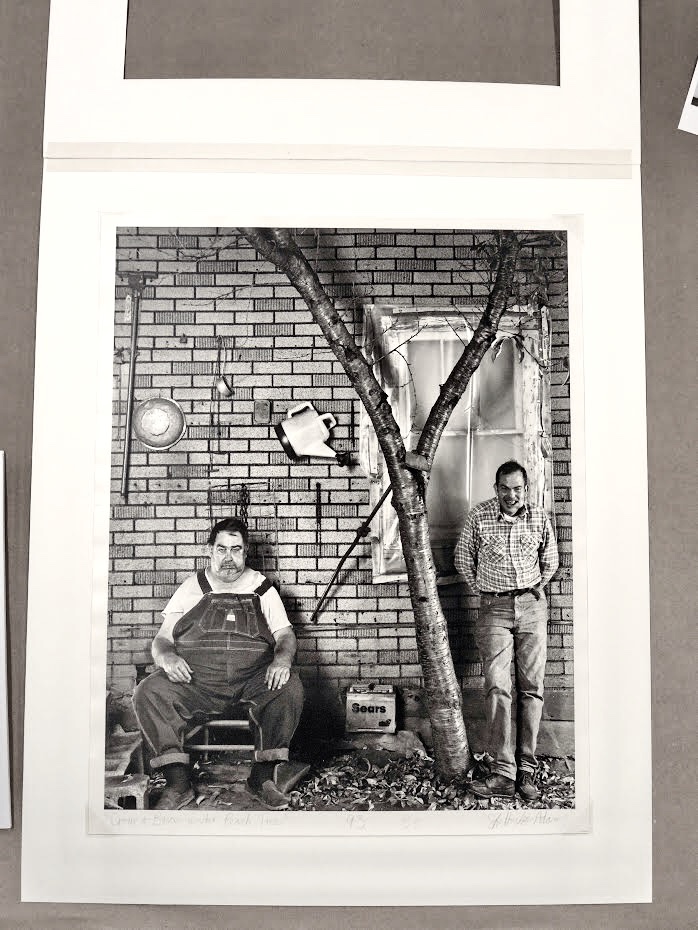SOLD. Shelby Lee Adams ‘Brice and Crow Under Peach Tree’ 1993
Paper size: 50 x 40 cm / 16 X 20 inches
Edition: 4/25. 1993
Signature or Estate Stamp: Signature
Condition: Mint
Provenance: STEPHEN BULGER Gallery, Toronto, Canada (original 1999 receipt available upon request)
Price: SOLD.
Collection of the Whitney Museum of American Art, New York: https://whitney.org/collection/works/18562
https://www.icp.org/browse/archive/constituents/shelby-lee-adams?all/all/all/all/0
Shelby Lee Adams (1950) American
Biography
Born in Kentucky in the town of Hazard, and later living with his grandparents in Hot Spot, Shelby Lee Adams discovered photography and the arts in high school. It was during this time that the Peace Corps sent a film crew to his town to document the poverty of Appalachia, which sparked Adams’ interest in the documentary style. He attended the Cleveland Institute of Art, where in his sophomore year he was exposed to the photographs of the Farm Security Administration. These pictures document the debilitating effects of the Depression in the South during the 1930s. Adams was able to relate to the images and the subjects, inspiring him to make the pictures for which he is now best known, his photographs of the people and culture of Appalachia. He began this project in 1973 and although he has done editorial work for publications like Fortune, GQ, New York Magazine, and the New York Times, he primarily focuses on portraits of the people of Appalachia.
Adams works primarily in black and white. He began with a 35mm camera and then switched to a 4×5. His crisp, poignant images show the people of Appalachia in their simple environments, revealing both the heroic and grotesque side to secluded mountain life. Adams photographs his subjects with an emphasis on the unpretty beauty of their immediate surroundings and their worn faces and clothes, their rudimentary living conditions starkly contrasted against the backdrop of a sublime landscape. But they are not depicted as victims; they confront the camera proudly and matter-of-factly. Adams considers his subjects his friends, which no doubt lends a level of comfort to the shooting sessions, as they face his large camera. In his most recent work, Adams documents the infiltration of progress and media into the folkways of the Appalachian people, capturing the displacement of an agrarian economy. Drawn to the attractions of pop culture and modern life, the Appalachian people are losing interest in living off the land.
Adams’ work has received a great deal of recognition. He is the recipient of a survey grant and photography fellowship from the National Endowment for the Arts (1978, 1992), along with an artist support grant four years running from the Polaroid Corporation (1989-92). His photographs are held in the permanent collections of many museums, including the Museum of Modern Art and the Whitney Museum of American Art, both in New York, the Art Institute of Chicago, the Smithsonian American Art Museum in Washington, D.C., the Harvard Fogg Museum in Cambridge, and the Victoria and Albert Museum in London.
Permanent collections
- Art Institute of Chicago, Chicago
- Museum of Contemporary Photography, Chicago
- International Center of Photography, New York City
- Musée de l’Élysée, Lausanne
- Museum of Modern Art, New York
- Fogg Museum, Cambridge, Massachusetts
- National Gallery of Canada, Ottawa
- San Francisco Museum of Modern Art
- Smithsonian American Art Museum, Washington, DC
- Stedelijk Museum, Amsterdam
- Time Life Collection, Rockefeller Center, New York
- Victoria and Albert Museum, London
- Whitney Museum of American Art, New York
- Middle Tennessee State University, Murfreesboro



